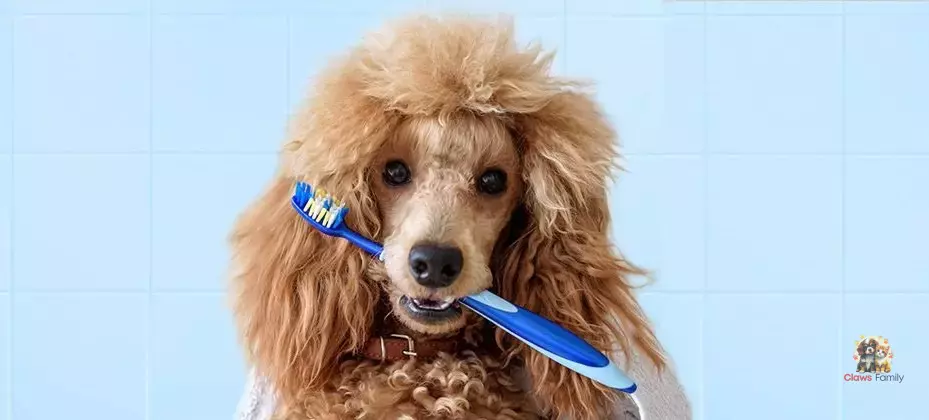Periodic hygiene is essential for a dog, not just for its appearance but also for its health. Neglecting its coat, ears, eyes, and paws can lead to serious health problems over time. Discover all the precautions for total hygiene of your furry friend here.
What Does Dog Care Include?
Grooming a dog isn’t just about brushing its coat. Its ears, eyes, paws, and teeth also need regular cleaning and care. Initially, your dog may not enjoy certain aspects of grooming. Start early and familiarize your puppy with a grooming routine, considering it a part of their education.
Each dog requires appropriate care that may take more or less time depending on various factors. Long-haired dogs demand more attention than short-haired ones. The environment in which a dog lives and its temperament also make a difference: a calm dog accustomed to indoor living needs less care than one that loves running and exploring in the woods. Care must be tailored to Fido's individual needs.
How to Clean the Coat?
Coat care is a key aspect of grooming, serving not only to remove dirt but also to prevent matting and detect pathological changes or parasites early. Regular maintenance reduces the time needed compared to sporadic cleaning when the coat is already dull and matted.
The appropriate care for your dog's coat depends on its type. Besides length, its structure is also important. A dog’s coat can be single-layered or multi-layered:
- Single-layered coat: Found in breeds like poodles, greyhounds, and ridgebacks.
- Multi-layered coat: Includes a topcoat and undercoat, typical of breeds like pugs, Labradors, and golden retrievers.
Both the topcoat and undercoat deteriorate over time. Dead hair should be brushed out to oxygenate the skin and prevent itching and eczema. It's wise to invest in a suitable brush for your dog.
Cleaning Long-haired Dogs
Single-layered long hair should be brushed and combed several times a day. Multi-layered long hair with a thick undercoat requires almost daily brushing and combing, especially in areas prone to matting like the head, muzzle, armpits, and paws. Specialized brushes for dense undercoats are available. If brushing isn’t enough, you can use clippers to remove stubborn mats. Smaller mats can be untangled with your fingers or with a mat splitter or blunt scissors.
Cleaning Short-haired Dogs
Short-haired coats require care depending on their density and shedding. Weekly brushing suffices for some breeds, while wiry-haired breeds with a thick undercoat may need more attention, especially during shedding periods. Clipping removes dead hair from the root and is best done by a professional.
How to Bathe a Dog?
When the coat is very dirty, your four-legged friend needs a bath. Ideally, limit baths to avoid disturbing the lipid layer that protects their fur. Overwashing can dehydrate the skin. Sensitive breeds with short, smooth hair are more prone to dehydration. If a bath is necessary, use a moisturizing, fragrance-free dog shampoo with a pH of 6.5.
Steps:
- Set the water to a lukewarm temperature and wet the coat, starting with the paws and gradually moving up, avoiding the head and ears at first.
- Gently lather the body.
- Wet the head and ears carefully, avoiding water inside the ears.
- Lather the head and ears with a small amount of shampoo and thoroughly rinse out any residue.
- Dry the dog with an absorbent towel.
- Finish drying in a warm, draft-free place. Brush the coat only once fully dry.
Note: Avoid bathing puppies as their protective layer of fur and skin isn’t fully developed and dehydrates quickly.
How to Care for a Dog’s Paws?
Complete grooming includes paw care. Fur between paw pads quickly mats, creating a favorable environment for ticks and mites. In winter, de-icing salts and grit worsen the situation. Tiny particles accumulate between pads, causing painful inflammation. Trim the fur between pads regularly, and apply protective sprays or ointments before going out. After walks, clean paws with warm water, dry them thoroughly, and apply balm to keep them soft and healthy.
Tip: Watch for excessive licking or nibbling of paws, which might indicate injury or irritation.
Long nails can curl and pierce the pad, causing pain and poor posture. Trim them regularly using special clippers, ensuring not to cut too short to avoid bleeding. If inexperienced, consult a vet.
Tips for Eye, Teeth, and Ear Hygiene
Eye Care
Cleaning a dog’s eyes is simple but crucial. Use a non-fraying damp cloth to gently remove secretions and crusts. Small breeds, such as pugs, often have irritated eyes due to dust. Clean their eyes after walks, especially in small dogs.
Note: Persistent tearing or redness could indicate an injury or condition. Consult a vet.
Ear Care
Dogs with floppy ears are prone to infections. While their ear canal is self-cleaning, excess wax can block it, leading to otitis or mites. Use a damp cotton cloth to gently clean the ear. Special cleaning solutions and wipes are also available.
Dental Hygiene
Dental care begins with diet. Hard, chewy food and bones promote natural cleaning. Special chew toys strengthen jaw muscles, massage gums, and polish teeth. If trained from a young age, you can brush your dog's teeth using special brushes and toothpaste.
Warning: Yellow or brown teeth, brown gum edges, or bad breath suggest dental issues or gum inflammation. Visit a vet immediately.
More: Dog News



